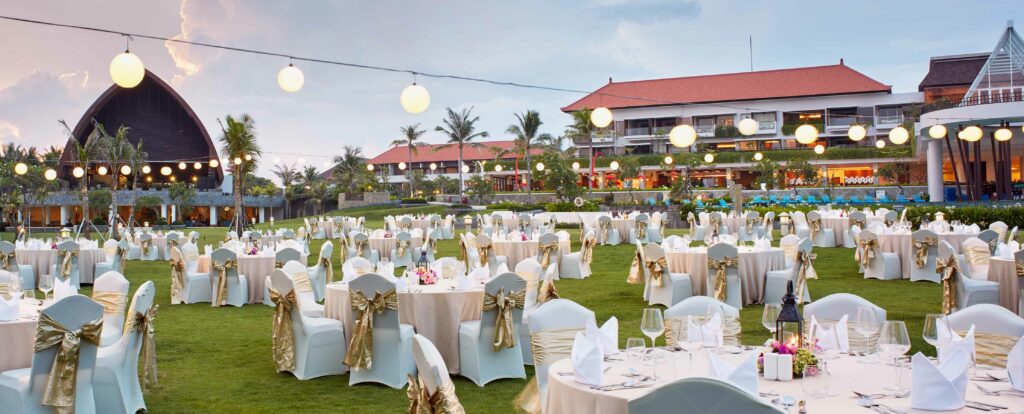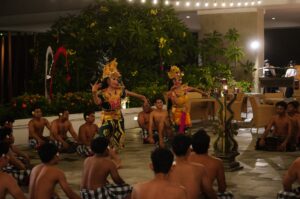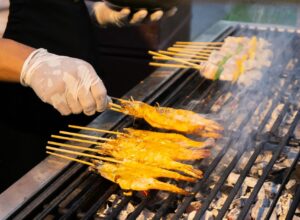A wedding celebrates a promise for the future. A vow renewal, on the other hand, celebrates a journey already taken. It honors a love that has deepened. It also celebrates a partnership that has flourished. A Bali vow renewal is a beautiful way to honor your enduring love story. It also reaffirms your lifelong commitment. And it all happens in one of the world’s most romantic settings.
A vow renewal in Bali is more than just a holiday. It is an opportunity to pause. It celebrates your shared history and the path you’ve walked together. It has all the romance of a wedding, but none of the stress. As your hosts at Merusaka Nusa Dua, we have created this simple guide. It will help you plan this profound and beautiful ceremony.
Why Renew Your Vows in Bali?
Choosing to reaffirm your commitment is a powerful milestone. Choosing to do it in Bali makes it an unforgettable memory.
- To Mark a Milestone: A vow renewal is the perfect way to celebrate a special anniversary. This is true whether it is your 10th, 25th, or 50th.
- It’s Simpler & More Intimate: There is no legal paperwork or large-scale planning required. Therefore, the entire focus is on you and your partner. It is a stress-free celebration of your love.
- A New Chapter: A vow renewal can be a beautiful way to mark a new chapter in your lives. It can also be a chance to have the romantic ceremony you may not have had the first time.
Planning Your Ceremony: Simple & Meaningful
 The beauty of a vow renewal is its simplicity and flexibility. You can create a ceremony that is a perfect reflection of you as a couple. Here are the key elements to consider.
The beauty of a vow renewal is its simplicity and flexibility. You can create a ceremony that is a perfect reflection of you as a couple. Here are the key elements to consider.
1. Choose Your Perfect Backdrop: The setting is the heart of your ceremony. In Bali, you are blessed with breathtaking options.
The Elegant Chapel: For a timeless, solemn, and beautiful ceremony, consider our Merusaka Wedding Chapel. Its soaring ceilings and serene ambiance provide a classic atmosphere.
The Romantic Beachfront: For a more relaxed “toes-in-the-sand” experience, a beachfront ceremony is pure magic. Reaffirm your vows on the soft, white sands of Mengiat Beach. You can do this as the sun sets over the ocean. The gentle waves will be your soundtrack.
2. Craft Your Vows: This is the soul of your ceremony. You can choose to write new vows. These new vows can reflect your journey together. Or, you can find special meaning in restating the original vows you made to each other years ago.
3. Add Personal & Balinese Touches: Make the ceremony uniquely yours. Consider incorporating a traditional Balinese flower blessing for good fortune. You could also have a solo musician play “your song.” Finally, you can hire a photographer to capture the intimate moments.
Beyond the Ceremony: The Celebration

After you’ve reaffirmed your commitment, the celebration continues. This is your chance to create a new romantic memory. It is just for the two of you.
- An Intimate Dinner for Two: Arrange a private, candlelit dinner on the beach. A personal server and a menu designed just for you will be there.
- A Rejuvenating Spa Journey: Indulge in a relaxing couples’ massage at The Spa at Merusaka. This helps you unwind and connect after your ceremony.
- A Family Affair: Are you celebrating with your children and family? A special group dinner at one of our signature restaurants is a wonderful way to include them.
Let Us Plan Your Reaffirmation
At Merusaka Nusa Dua, we believe every chapter of a love story deserves to be celebrated. We specialize in creating these beautiful, intimate moments. They honor a lifetime of love.
Our dedicated events team can help you plan every detail of your Bali vow renewal. We can help from securing the perfect venue to arranging a celebrant. We can also organize flowers and a romantic dinner. Just let us handle all the details. This way, you can focus completely on each other.



 Don’t be put off by the strange exterior! Salak, or Snake Fruit, is one of Bali’s most unique and iconic fruits.
Don’t be put off by the strange exterior! Salak, or Snake Fruit, is one of Bali’s most unique and iconic fruits. You can’t miss this one! Dragon Fruit is arguably the most beautiful and “Instagrammable” fruit on the planet.
You can’t miss this one! Dragon Fruit is arguably the most beautiful and “Instagrammable” fruit on the planet. Ah, the Durian. This is the most famous and infamous fruit in all of Southeast Asia. You will likely smell it before you see it!
Ah, the Durian. This is the most famous and infamous fruit in all of Southeast Asia. You will likely smell it before you see it! Step into a world of authentic Balinese celebration. Our BBQ Cultural Night is a vibrant, immersive experience. It brings the magic of the island’s most cherished traditions right to your table. We hold it every Thursday evening at our
Step into a world of authentic Balinese celebration. Our BBQ Cultural Night is a vibrant, immersive experience. It brings the magic of the island’s most cherished traditions right to your table. We hold it every Thursday evening at our 

 The villa experience at Merusaka is the ultimate expression of a Bali holiday. It is the
The villa experience at Merusaka is the ultimate expression of a Bali holiday. It is the 
 The best part of this itinerary is that we can flawlessly customize and arrange it for your group. Our dedicated team will help. When you host your event at a premier Bali conference venues like Merusaka, our MICE and Concierge teams become your partners in planning. We handle all the logistics. For example, we book spa treatments and golf tee times. We also arrange private group dinners and transportation. This leaves you free to focus on your delegates.
The best part of this itinerary is that we can flawlessly customize and arrange it for your group. Our dedicated team will help. When you host your event at a premier Bali conference venues like Merusaka, our MICE and Concierge teams become your partners in planning. We handle all the logistics. For example, we book spa treatments and golf tee times. We also arrange private group dinners and transportation. This leaves you free to focus on your delegates. 1. Amed & Jemeluk Bay (East Bali) This is a relaxed fishing village. It’s on Bali’s east coast and is a snorkeler’s paradise. The bay is very calm. You can enter the water from a beautiful black sand beach. Just a few meters from shore, you’ll find healthy coral gardens. They are teeming with colorful fish. You can even find a unique underwater “post office” sculpture.
1. Amed & Jemeluk Bay (East Bali) This is a relaxed fishing village. It’s on Bali’s east coast and is a snorkeler’s paradise. The bay is very calm. You can enter the water from a beautiful black sand beach. Just a few meters from shore, you’ll find healthy coral gardens. They are teeming with colorful fish. You can even find a unique underwater “post office” sculpture. 3. Blue Lagoon (Padang Bai) This sheltered bay is near the port town of Padang Bai. The Blue Lagoon is like a natural aquarium. The water is typically crystal clear and very calm. It has a white sandy bottom. It’s famous for its large, friendly fish. It is an incredibly rewarding spot for a first-time snorkeler.
3. Blue Lagoon (Padang Bai) This sheltered bay is near the port town of Padang Bai. The Blue Lagoon is like a natural aquarium. The water is typically crystal clear and very calm. It has a white sandy bottom. It’s famous for its large, friendly fish. It is an incredibly rewarding spot for a first-time snorkeler.

